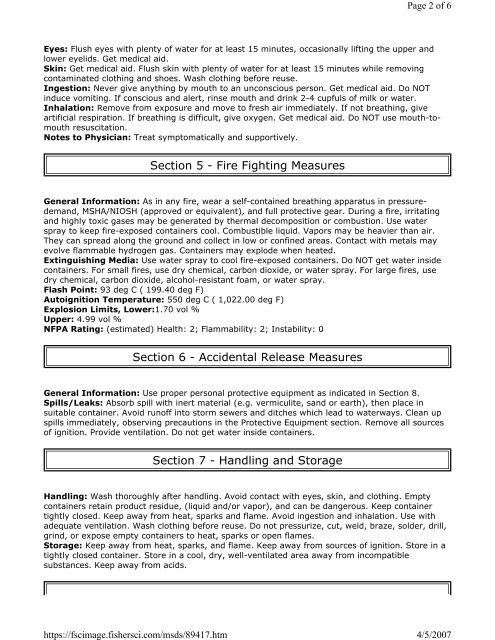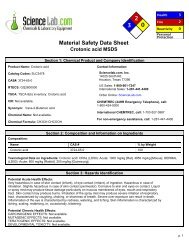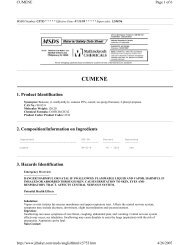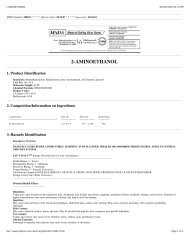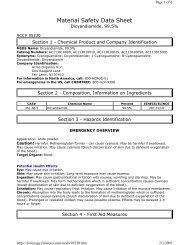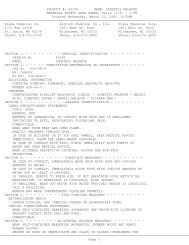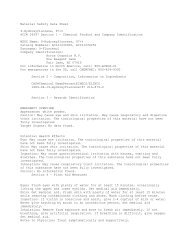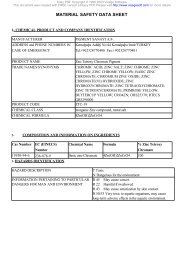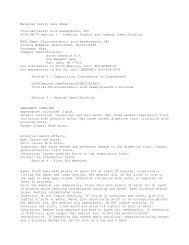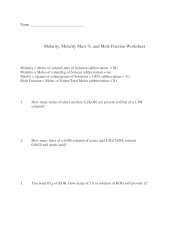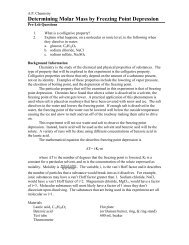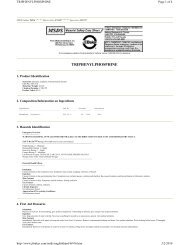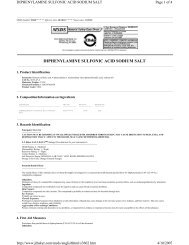MSDS PDF/A/Adiponitrile.pdf
MSDS PDF/A/Adiponitrile.pdf
MSDS PDF/A/Adiponitrile.pdf
Create successful ePaper yourself
Turn your PDF publications into a flip-book with our unique Google optimized e-Paper software.
https://fscimage.fishersci.com/msds/89417.htm<br />
Page 2 of 6<br />
4/5/2007<br />
Eyes: Flush eyes with plenty of water for at least 15 minutes, occasionally lifting the upper and<br />
lower eyelids. Get medical aid.<br />
Skin: Get medical aid. Flush skin with plenty of water for at least 15 minutes while removing<br />
contaminated clothing and shoes. Wash clothing before reuse.<br />
Ingestion: Never give anything by mouth to an unconscious person. Get medical aid. Do NOT<br />
induce vomiting. If conscious and alert, rinse mouth and drink 2-4 cupfuls of milk or water.<br />
Inhalation: Remove from exposure and move to fresh air immediately. If not breathing, give<br />
artificial respiration. If breathing is difficult, give oxygen. Get medical aid. Do NOT use mouth-tomouth<br />
resuscitation.<br />
Notes to Physician: Treat symptomatically and supportively.<br />
Section 5 - Fire Fighting Measures<br />
General Information: As in any fire, wear a self-contained breathing apparatus in pressuredemand,<br />
MSHA/NIOSH (approved or equivalent), and full protective gear. During a fire, irritating<br />
and highly toxic gases may be generated by thermal decomposition or combustion. Use water<br />
spray to keep fire-exposed containers cool. Combustible liquid. Vapors may be heavier than air.<br />
They can spread along the ground and collect in low or confined areas. Contact with metals may<br />
evolve flammable hydrogen gas. Containers may explode when heated.<br />
Extinguishing Media: Use water spray to cool fire-exposed containers. Do NOT get water inside<br />
containers. For small fires, use dry chemical, carbon dioxide, or water spray. For large fires, use<br />
dry chemical, carbon dioxide, alcohol-resistant foam, or water spray.<br />
Flash Point: 93 deg C ( 199.40 deg F)<br />
Autoignition Temperature: 550 deg C ( 1,022.00 deg F)<br />
Explosion Limits, Lower:1.70 vol %<br />
Upper: 4.99 vol %<br />
NFPA Rating: (estimated) Health: 2; Flammability: 2; Instability: 0<br />
Section 6 - Accidental Release Measures<br />
General Information: Use proper personal protective equipment as indicated in Section 8.<br />
Spills/Leaks: Absorb spill with inert material (e.g. vermiculite, sand or earth), then place in<br />
suitable container. Avoid runoff into storm sewers and ditches which lead to waterways. Clean up<br />
spills immediately, observing precautions in the Protective Equipment section. Remove all sources<br />
of ignition. Provide ventilation. Do not get water inside containers.<br />
Section 7 - Handling and Storage<br />
Handling: Wash thoroughly after handling. Avoid contact with eyes, skin, and clothing. Empty<br />
containers retain product residue, (liquid and/or vapor), and can be dangerous. Keep container<br />
tightly closed. Keep away from heat, sparks and flame. Avoid ingestion and inhalation. Use with<br />
adequate ventilation. Wash clothing before reuse. Do not pressurize, cut, weld, braze, solder, drill,<br />
grind, or expose empty containers to heat, sparks or open flames.<br />
Storage: Keep away from heat, sparks, and flame. Keep away from sources of ignition. Store in a<br />
tightly closed container. Store in a cool, dry, well-ventilated area away from incompatible<br />
substances. Keep away from acids.


